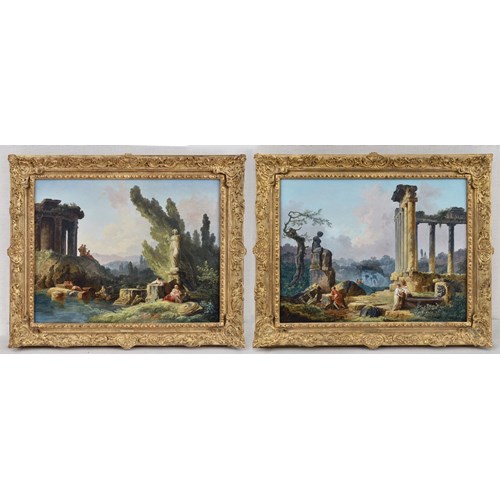Carlo Dolci
Saint Mark the Evangelist
Medium Oil on canvas
Dimension 101.5 x 83 cm (40⁰/₁ x 32⁵/₈ inches)
Baldinucci also records that the four octagonal pictures 'were bought by Giovambatista Galli for 120 scudi [and] Carlo then worked on the pictures again, rendering them even more beautiful'. Giovanni Battista Galli, born in 1642, had inherited from his father Agnolo a fine collection of Florentine seicentopaintings, including Lorenzo Lippi's Triumph of David, which contains portraits of Giovanni Battista, his mother and his fifteen siblings, painted in 1656 (exhibited Florence, Palazzo Strozzi, Il Seicento Fiorentino, Arte a Firenze da Ferdinando I a Cosimo III, 21 December 1986 4 May 1987, Pittura, pp. 346-8, no. 1.184). He took the opportunity to purchase the present picture and its companions in order to augment the collection in the family palace in via Pandolfini, where 'the four Evangelists by Dolci' were noted by Giovanni Cinelli in 1677 (loc. cit.).
They are next recorded at the end of the seventeenth century in the collection of Cosimo Riccardi (1671-1751), and appear in various inventories of the family palazzo on the via Larga (the Palazzo Medici-Riccardi) throughout the eighteenth century. In 1810, they were acquired from the family by Napoleon's brother, Lucien Bonaparte, Prince of Canino, who was in Italy from 1804 until 1810. On his way to America in 1810, Bonaparte was captured at sea by the British and held in London until 1814. He returned to Rome after his release, but his collection of paintings was consigned in London for sale, for reasons that have never been completely understood, possibly financial in nature. While in Bonaparte's collection Buchanan remarked that 'of the works of this esteemed master none exist which hold a higher rank, or have been more esteemed than the Four Evangelists in this collection'. They formed part of the principal ornaments of the Riccardi Gallery at Florence' (loc. cit.).
When the collection was sold the series was dispersed; Saint Matthewand Saint John the Evangelistbeing sold privately to Sir Simon Clarke, while Saint Markand Saint Lukewere included in the public sale held by Stanley in London on 16 May 1816. Buchanan does not record who bought Saint Markbut the price it achieved, £125, was extraordinary for the time. It later reappeared in the collection of William, Prince of Orange, subsequently King William II of the Netherlands, by 1837. This collection was considered by contemporaries to be one of the finest in Europe. By 1838, the then-Prince had already assembled an impressive group of Old Master pictures and drawings, including Raphael's Head of a Muse(sold at Christie’s London, 8 December 2009, lot 43, £29.2 million), which appeared alongside the present work in the 1850 sale of the King's collection (as lot 24). It is revealing of contemporary taste to note that the Dolci was then valued at more than ten times the price realized for the previously mentioned Raphael drawing.
Two of the other three Evangelists from the series can be traced today: Saint Matthewis in the J. Paul Getty Museum, Malibu (Baldassari, op. cit., 1995, no. 30; see fig. 1), and Saint John, sold at Christie's, New York, 11 January 1995, lot 99, is now in a European private collection; The fourth canvas of Saint Lukewas last recorded in the Morrison Collection at Basildon Park, but its current location is unknown.
Medium: Oil on canvas
Dimension: 101.5 x 83 cm (40⁰/₁ x 32⁵/₈ inches)
Provenance:
Painted for the artist's
confessor (probably Domenico Carpanti), Florence (according to
Baldinucci, see below);
Giovanni Battista Galli (b. 1642), who purchased the set
(possibly from the above) for 120 scudi before 1677, Palazzo Galli,
via Pandolfini, Florence;
Marchese Cosimo Riccardi (1671-1751), Palazzo
Medici-Riccardi, and by descent until 1810;
Then acquired by Lucien Bonaparte (1775-1840);
Sale, Stanley's, London, 16 May 1816, lot 154, 'St. Mark,
forming one of the Series of Four Evangelists, formerly in the Riccardi Palace.
The character of the Head, the drawing of the Hands, and the cast of the
Draperies, are excellent'; Acquired
by Nieuwenhuys, Paris, 8 July 1826;
William, Prince of Orange, subsequently King William II of
the Netherlands (1792-1849), by 1837;
His estate sale, J. de Vries, C. F. Roos, J. A. Brondgeest,
The Hague, 12-20 August 1850, lot 153, erroneously described as Saint Luke,
'L'apôtre est représenté écrivant l'Évangile. Son attitude indique qu'il
est plongé dans la réflexion; dans l'ombre on découvre un lion. Ce beau tableau,
quoique d'un grand fini, est peint d'une maniére large, et les couleurs y
ont cette transparence qu'on admire dans toutes les oeuvres de l'artiste',
14 October 1850;
Purchased by Friedrich zu Wied, Prince of the Netherlands;
By inheritance to Marie zu Wied, Princess of the
Netherlands, Schloss Neuwied, Germany;
Her estate sale, Sotheby's, 5 July 1967, lot 18, as 'C.
Dolci', to Waddingham;
Anonymous sale. Christie's, London, 8 December 1995, lot
103, where purchased by the former owners
Literature: Please Ask Gallery - Extensive Literature
Exhibition:
Florence, Cloister of Santissima
Annunziata, 1729;
(Possibly) Florence, Cloister of Santissima Annunziata, 1767;
William II and Anna Pavlova – Royal Splendor at the
Dutch Court, St. Petersburg, Russia, State Hermitage, September 24, 2013 –
January 12, 2014;
Dordrecht, Dordrecht Museum, February 15 – May 18, 2014;
Wellesley, Massachusetts, Davis Museum, Wellesley College, The
Medici’s Painter: Carlo Dolci and 17th Century Florence,
February 8, 2017 – July 9, 2017
More artworks from the Gallery









